BestReviews is reader-supported and may earn an affiliate commission. Details
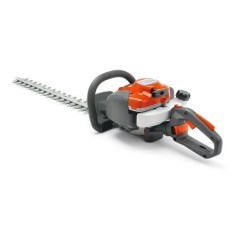
The smart start engine on this powerful and versatile hedge trimmer makes starting up as easy as the trimming is.
The smart start engine on this powerful and versatile hedge trimmer makes starting up as easy as the trimming is.
This lightweight trimmer was built for the 21st century, with a carburetor air purge system that keeps the engine running smoothly and reliably. It automatically returns to the start position when you're done. The quiet engine and anti-vibration dampeners on the handle make using it an enjoyable experience.
The handle is quite short. Some have a hard time maintaining it for constant use.
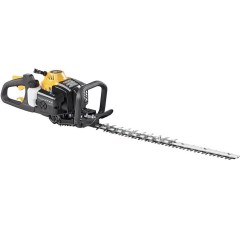
An inexpensive and powerful trimmer that's easy to maneuver and is ideal for most consumers' needs.
An inexpensive and powerful trimmer that's easy to maneuver and is ideal for most consumers' needs.
Dual 22" stainless steel blades can handle fairly thick branches and are rust-resistant in combination with proper care. Durable, 23cc, 2-cycle, full crank engine with an easy-fill fuel tank. At roughly 11 lbs, it's easy for most consumers to hold and operate. Budget-friendly price.
Some issues with the pull-start mechanism have been reported.
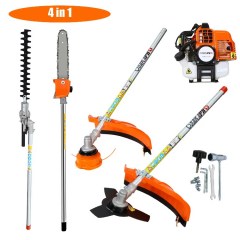
This 4-in-1 gas-powered trimmer also has a brush cutter, a rotatable pole saw, and a full crankshaft.
This 4-in-1 gas-powered trimmer also has a brush cutter, a rotatable pole saw, and a full crankshaft.
The versatile design made with high-quality materials works equally well on small, suburban yards and vast, open areas. The humanized design moves with you and won't cause needless difficulties as you go. Shoulder straps keep you well-balanced despite this unit's massive size.
It weighs 28 lbs with a full tank of gas, so don't throw your back out.
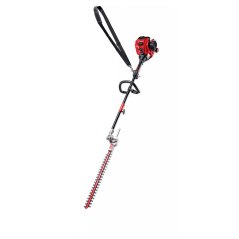
The articulating head on this 22" trimmer offers full flexibility as you work.
The articulating head on this 22" trimmer offers full flexibility as you work.
The heavy-duty case can withstand prolonged use. Its 25cc engine is powerful yet surprisingly comfortable to use. The adjustable handle reduces obnoxious and potentially debilitating vibrations as you work. Buyers love this hedge trimmer's performance at an affordable price.
Don't skip arm day; it weighs 17 lbs with a full tank of gas.
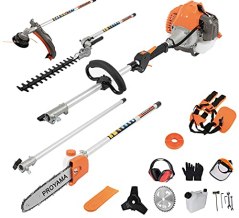
Though not as reliable as similarly priced models, this 5-in-1 trimmer is well suited to a variety of trimming and pruning tasks.
Though not as reliable as similarly priced models, this 5-in-1 trimmer is well suited to a variety of trimming and pruning tasks.
With the extra cost comes more power and 5 versatile attachments. Has an 18-inch hedge trimmer blade and an adjustable length of 8.2 feet to 11.4 feet. Comes with a 1-year warranty and the manufacturer offers excellent customer service.
This trimmer is both heavy and flimsy. Poor instructions.

We recommend these products based on an intensive research process that's designed to cut through the noise and find the top products in this space. Guided by experts, we spend hours looking into the factors that matter, to bring you these selections.

If you have extensive hedging to maintain, there is just no substitute for a good gas hedge trimmer. Cordless hedge trimmers are credible and improving, but they still struggle to compete when it comes to absolute power and all-day working capability. And as for dragging a cord around the yard for hundreds of feet? It’s not really a practical solution.
For homeowners with a large garden or professionals who do this kind of work for a living, a gas hedge trimmer is still the tool of choice, but which one? From the motor to the blade to the handle, from budget-friendly to expensive, there are several factors to consider as you shop.
We’ve made some recommendations that offer something for those on a budget and for those looking for high performance. In the buying guide below, we look at all of the important aspects in more detail.

Cycles: With many types of gas-powered garden equipment, you have a choice of four-cycle or two-cycle motors. Four-cycle motors tend to be more durable and slightly quieter, and they run a little cleaner, but they have one major drawback: weight.
For that reason, gas hedge trimmers invariably have a two-cycle motor, and most of the models we looked at were somewhere between 21 and 25 cubic centimeters (cc). That would suggest they all produce similar output, which is true, and the weight only varies by a pound or two. The only real difference between the budget and premium brands is component quality and thus durability.
Emissions: Some manufacturers have put considerable effort into reducing emissions, and the best two-cycle motors are now California Air Resources Board (CARB) and/or Environmental Protection Agency (EPA) compliant. This is becoming increasingly important. There are now 15 states that ban tools that don’t meet the CARB standard.
Horizontal blades: There are two basic configurations for gas hedge trimmers. The most popular is a unit similar in appearance to a chainsaw, but with the blade running horizontally rather than vertically. This gives you a machine that’s well balanced and easy to manage, which is particularly important if you have tall hedges that you have to stand on a ladder or scaffold to cut. It also makes for a more manageable tool for general trimming duties on low hedges and plants.
End blades: The other format looks more like a pole saw or string trimmer, with blades on the end. The pole gives you greater reach, and the head is usually articulated so you can set the blades at the required angle. The drawback with this kind of hedge trimmer is that while you’re more likely to be able to stand on the ground, which is safer, the tool isn’t as easy to control because it can be difficult to see exactly where the blades are cutting. This can lead to an untidy finish. Shorter shafts are available, but for us that seems to negate the benefits of a shaft in the first place.
Inexpensive: The dominance of battery-powered hedge trimmers at this end of the market means the choice is limited. Nevertheless, there are excellent values at around $150. You’ll find a few cordless models in this price range, but one that delivers equivalent power will probably be twice as much.
Mid-range: There’s greater choice in this part of the market, with several high-performance tools between $220 and $330. These provide ample capacity and durability for most homeowners
Expensive: Professionals who want tools with articulation or the larger blade sizes will need to invest between $400 and $500.


Q. Do gas hedge trimmers need much maintenance?
A. Not a huge amount, but it’s important to follow the manufacturer’s instructions carefully to maximize the tool’s working life. Usually this amounts to general cleaning, lubrication, and periodically replacing the air filter and/or spark plug.
Q. How often do I need to sharpen the hedge trimmer blades?
A. It varies from one manufacturer to another, and it depends to some extent on the blade material, but most recommend about every 50 hours. Only sharpen the cutting edges, not the flat areas they cut against. If you’re unsure, find a hardware store or garden outlet that can do the job for you.
If a hedge trimmer isn’t cutting well, it isn’t always that the blades are blunt. It could be a buildup of sappy or resinous material from cutting plants like fir or pine. Clean off the residue with a spirit-based cleaner and a stiff brush.
Q. Are there any special instructions for storing a hedge trimmer out of season?
A. If you’re not going to be using your hedge trimmer for a few months, drain any remaining fuel (and use fresh when you start it again). If you store the tool in a damp shed or garage, moisture will encourage rust. A waterproof canvas case is the best storage. Alternatively, wrap the hedge trimmer in cotton or similar (old towels or T-shirts will do) and then in a large plastic bag.
Get emails you’ll love.
Learn about the products you’re wondering if you should buy and get advice on using your latest purchases.
